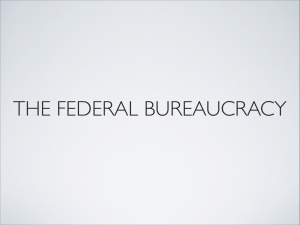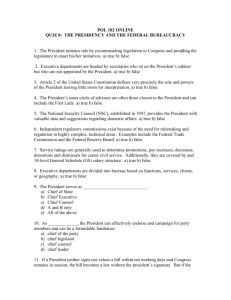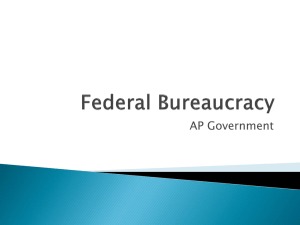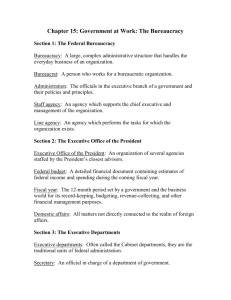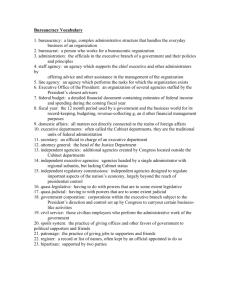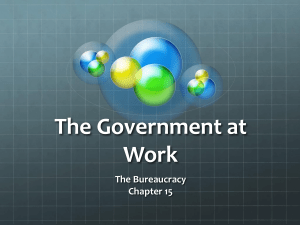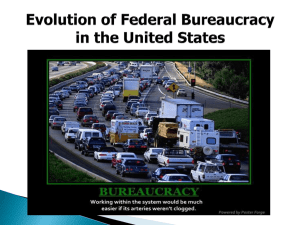Chapter 1 - ohstrailblazers
advertisement
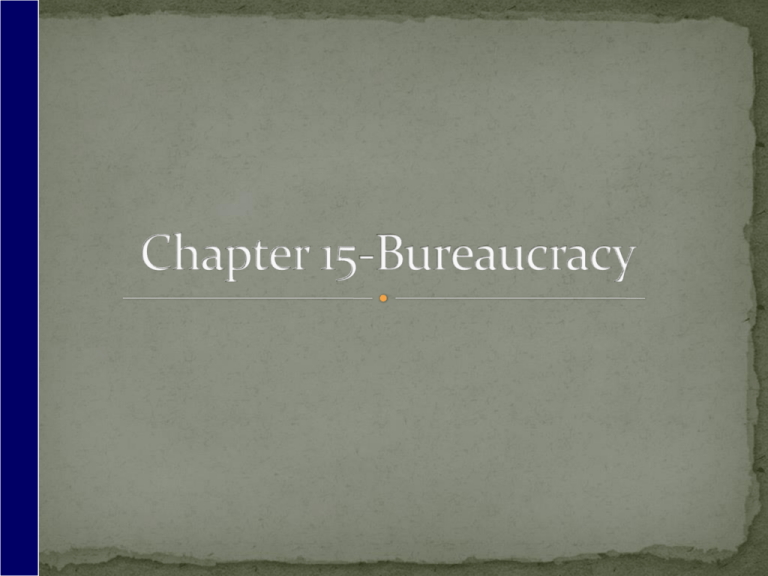
Bureaucracy A set of complex hierarchical departments, agencies, commissions, and their staffs that exist to help a chief executive officer carry out his or her duties Bureaucracies may be private organizations of government. 1789 only three departments under the Articles of Confederation Foreign Affairs, War, and Treasury Washington inherited these. Head of each called a “secretary” Foreign Affairs renamed Department of State 1816 to 1861 size increased and demands increased Post Office expanded as country grew Major source of jobs (spoils system/patronage) Civil War spawned need for new government agencies. Department of Agriculture (1862) Not given Cabinet-level status until 1889 Pension Office (1866) Department of Justice (1870) Spoils system The firing of public-office holders of a defeated political party and their replacement with loyalists of the newly elected party Patronage Jobs, grants, or other special favors that are given as rewards to friends and political allies for their support Garfield’s presidency Besieged by office-seekers (patronage seekers) Wished to reform the system Irony: assassinated by a frustrated job seeker Reaction to Garfield’s death and increasing criticism of the spoils system was the Civil Service Reform Act in 1883 Also called the Pendleton Act Reform measure that created the Civil Service Commission to administer a partial merit system The act classified the federal service by grades to which appointments were made based on the results of a competitive examination. It made it illegal for federal political appointees to be required to contribute to a particular political party. Civil service system operated to 1978 New version is the merit system Growth of big business, price fixing, and other unfair business practices after the Civil War stimulated Congress to create the Interstate Commerce Commission First independent regulatory commission An agency created by Congress that is generally concerned with a specific aspect of the economy Theodore Roosevelt Department of Commerce and Labor Woodrow Wilson Divided it into two separate departments Encouraged Congress to create the Federal Trade Commission 16th Amendment Franklin Roosevelt Great Depression FDR created hundreds of new government agencies to regulate business practices and various other areas of the national economy. WWII Affected the economy Manufacturing of goods related to the war Tax rates increased and never fell again After the war Demands for services/new money infusion=more government Civil Rights Movement War on Poverty Who Are Bureaucrats 2.7 million federal workers 1/3 in the U.S. Postal Service Tests usually for entry-level positions Mid-level to upper ranges of federal positions do not normally require tests. 10 percent of federal workforce not covered by civil service. Appointive policy-making positions (cabinet secretaries, for example)- Schedule C Independent Regulatory Commissioners (appointed by the president) Low-level, non-policy patronage positions Secretarial assistants to policy makers, for example Many located in Washington, D.C., but many are spread out throughout the country (decentralized) Graying of the federal workforce Hiring of outside contractors Cabinet Departments Major administrative units with responsibility for a broad area of government operations Indicates a permanent national interest Government Corporations Businesses established by Congress that perform functions that could be provided by private businesses Example: Amtrak, Federal Deposit Insurance Corporation Independent Executive Agencies Governmental units that closely resemble a Cabinet department but have a narrower area of responsibility and are not part of any Cabinet Department Example: Central Intelligence Agency Independent Regulatory Commissions Agencies created by Congress to exist outside the major departments to regulate a specific economic activity or interest Example: Federal Reserve Board Hatch Act Law enacted in 1939 to prohibit civil servants from taking activist roles in partisan campaigns Could not make political contributions, work for a political party or campaign for a particular candidate Federal Employees Political Activities Act 1993 liberalization of the Hatch Act Allowed federal employees to run for office in nonpartisan elections and to contribute money to campaigns in partisan elections Weber Chain of command Division of labor/specialization Clear lines of authority Goal orientation Impersonality Productivity Implementation The process by which a law or policy is put into operation by the bureaucracy Iron triangles Relatively stable relationships and patterns of interaction that occur among an agency, interest groups, and congressional committees or subcommittees Issue networks The loose and informal relationships that exist among a large number of actors who work in broad policy area Interagency Councils: working groups that bring together representatives of several departments and agencies to facilitate the coordination of policy making and implementation Increasing complexity of policy domains Interagency councils Administrative discretion The ability of bureaucrats to make choices concerning the best way to implement congressional intentions Rule making A quasi-legislative administrative process that has the characteristics of a legislative act Regulations Rules that govern the operation of a particular government program that have the force of law 1946 Administrative Procedures Act Public notice of time, place and nature of rule-making proceedings provided in the Federal Register Submission of written arguments Statutory purpose and basis of rule to be stated Once rule is written, 30 days must elapse before it takes effect. Administrative adjudication A quasi-judicial process in which a bureaucratic agency settles disputes between two parties in a manner similar to the way courts resolve disputes Executive Control Appointments Executive orders Rules or regulations issued by the president that have the effect of law Congressional Control Constitutional powers Power of the purse General Accounting Office, Congressional Research Service, and Congressional Budget Office Judicial Control
